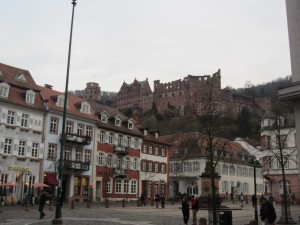Word came this week of two resolutions of claims to Nazi-looted art in museums in New York and Cologne, and a new Nazi-looted claim against Germany filed in Washington. Barely a month after the Neue Galerie (of Austrian and German art) in New York announced that it had discovered a “major work” in its collection had a clouded history, the museum announced an agreement concerning the Karl Schmitt-Rotloff painting Nude (1914). It is not known if the Schmitt-Rotloff is the same work to which the museum referred last month. Around the same time, the Wallraff-Richartz-Museum in Cologne, Germany, announced that it had agreed to return a drawing by Adolf Menzel that had been sold to Hildebrand Gurlitt as its owners fled Nazi Germany in the 1930s. Blick über die Dächer von Schandau (View over the rooves of Schandau) (1886) will be retuned to the heirs of Hamburg attorney Albert Martin Wolffson and his daughter Elsa Helene Cohen. These settlements are examples of constructive dialogue and enlightened treatment of the historical fact. The new litigation likely means the opposite approach from the German defendants.
Restitution Claims Resolved in New York and Cologne, New Case Filed Against Germany
Topics: Cologne, Schwabinger Kunstfund, Breslau, Gurlitt Task Force, Germany, Wallraf-Richartz Museum, Nazi-looted art, 28 U.S.C. 1605(a)(3), Gurlitt, David Toren, Neue Galerie, Ernst Ludwig Kirchner, New York, Karl Schmitt-Rotloff, Alfred and Tekla Hess, Streen Scene in Berlin, Adolf Menzel, Strassenzene
Recap of Ersessene Kunst—Der Fall Gurlitt (Appropriated Art—The Gurlitt Case): January 26, 2014 in Heidelberg
I’ve just returned from my presentation in Heidelberg at the Hochschule für Jüdische Studien in Heidelberg at the conference Ersessene Kunst—Der Fall Gurlitt; Appropriated Art—The Gurlitt Case. The presentations were, without exception, outstanding. They ranged from rarely-told case stories, to sharp insights of some of the overarching principles that guide the the Gurlitt case and similar events. As the discussions made clear, this case will not be easily resolved. That in turn makes recent reports that Cornelius Gurlitt has indicated a willingess to discuss the art's return all the more significant.
Topics: Maria Altmann, Leopold Reidemester, Ministerin für Justiz und Kultur, Stuttgart, Das Alte Schauspielhaus, Cologne, Irina Alter, Portrait of Adele Bloch-Bauer, veschollene Kunst, Focus, Schwabinger Kunstfund, Aschbach Castle, Mussolini, Wiedergutmachung, Annette Weber, Monte Cassino, Cornelius Gurlitt, Corinna Budras, S. Lane Faison, Breslau, Universität Heidelberg, Augsburg, Aryanization, Anat Feinberg, Willi Korte, Schwabinger Kunstfund. Kunstfund München, Monuments Man, Jud Süss, Wrocław, Dresden, Gurlitt Task Force, Germany, Silesia, Fall Gurlitt, Wallraf-Richartz Museum, Köln, Nazi-looted art, Henry Keazor, Gurlitt Collection, Appropriated Art the Gurlitt Case, Schloss Aschbach, Die Welt, Kurpfälzische Museum Heidelberg, Hochschule für Judische Studien Heidelberg, Karl Haberstock, Eberhard Karls-Universität Tübingen, Emily Löffler, CSU, Williams College, Hildebrand Gurlit, Entartete Kunst, Universität Zürich, Arisierung, Lehrstuhl für Römisches Recht und Privatrecht, Württemberg, Schlesien, Nürnberger Institut, Hamburg, Otto Förster, Rückgabe, Beutekunst, 'Stürmer-Bibliothek', Magdeburg, Portrait of Amalie Zuckerkandl, Ersessene Kunst, Katja Terlau, Art Loss Recovery Unit, Jim Tobias, Hermitage, Gurlitt, Bavaria, Johannes Heil, Wien, Sullivan & Worcester LLP, Lucas Elmenhorst, Events, Kunsthistorisches Institut, Nürnberg, Jüdisches Museum Frankfurt, Looted Art, „Sturmer-Library“, degenerate art, Seminar für Neuere Geschichte, Wolfgang Ernst, Justizminister, Göring, www.lostart.de, Nazi art, Raubkunst, Nicholas M. O'Donnell, Frieder Hepp, Verjährung, Vienna, Claudius Krausharr, Münchner Kunstfund, Zwickau, Kajetan Mühlmann, New York, Werner Haftmann, FAZ Frankfurt, Felicitas Heiman-Jellinek




